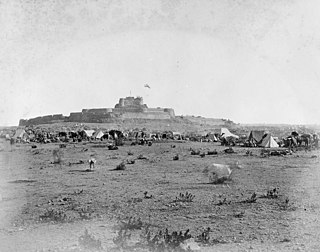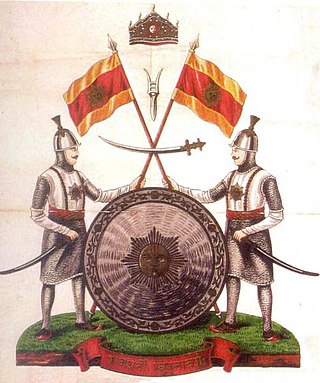The Dogras or Dogra people, are an Indo-Aryan ethno-linguistic group living primarily in the Indian union territory of Jammu and Kashmir and neighbouring Pakistan, consisting of the Dogri language speakers. They live predominantly in the Jammu region of Jammu and Kashmir, and in adjoining areas of Punjab and Himachal Pradesh. Some also live in northeastern Pakistan. Their historical homeland is known as Duggar.

The Sikh Empire was a regional power based in the Punjab region of the Indian subcontinent. It existed from 1799, when Maharaja Ranjit Singh captured Lahore, to 1849, when it was defeated and conquered by the British East India Company in the Second Anglo-Sikh War. It was forged on the foundations of the Khalsa from a collection of autonomous misls. At its peak in the 19th century, the empire extended from Gilgit and Tibet in the north to the deserts of Sindh in the south and from the Khyber Pass in the west to the Sutlej in the east as far as Oudh. It was divided into four provinces: Lahore, which became the Sikh capital; Multan; Peshawar; and Kashmir from 1799 to 1849. Religiously diverse, with an estimated population of 4.5 million in 1831, it was the last major region of the Indian subcontinent to be annexed by the British Empire.

Hari Singh Nalwa was the commander-in-chief of the Sikh Khalsa Fauj, the army of the Sikh Empire. He is known for his role in the conquests of Kasur, Sialkot, Attock, Multan, Kashmir, Peshawar and Jamrud. Hari Singh Nalwa was responsible for expanding the frontier of Sikh Empire to beyond the Indus River right up to the mouth of the Khyber Pass. At the time of his death, Jamrud constituted the western boundary of the Empire.

Maharaja Gulab Singh Jamwal (1792–1857) was the founder of Dogra dynasty and the first Maharaja of the princely state of Jammu and Kashmir, which was a part of Sikh Empire became the largest princely state under the British Raj, which was created after the defeat of the Sikh Empire in the First Anglo-Sikh War. During the war, Gulab Singh would later side with the British and end up becoming the Prime Minister of Sikh Empire. The Treaty of Amritsar (1846) formalised the transfer of all the lands in Kashmir that were ceded to them by the Sikhs by the Treaty of Lahore.

Zorawar Singh was a military general of the Dogra Rajput ruler, Gulab Singh, who served as the Raja of Jammu under the Sikh Empire. He served as the governor (wazir-e-wazarat) of Kishtwar and extended the territories of the kingdom by conquering Ladakh and Baltistan. He also boldly attempted the conquest of Western Tibet but was killed in battle of To-yo during the Dogra-Tibetan war. In reference to his legacy of conquests in the Himalaya Mountains including Ladakh, Tibet, Baltistan and Skardu as General and Wazir, Zorowar Singh has been referred to as the "Napoleon of India", and "Conqueror of Ladakh".

Rajouri or Rajauri is a city in the Rajouri district in the Jammu division of the Indian union territory of Jammu and Kashmir. It is located about 155 kilometres (96 mi) from Srinagar and 150 km (93 mi) from Jammu city on the Poonch Highway. The city is the location of the birthplace of Sikh General Banda Singh Bahadur. Baba Ghulam Shah Badshah University is also situated in this district. It is Known as The Land of Kings. The Jarral Rajputs were the Highest Ruling Dynasty of The Rajouri District. They Ruled Rajouri For 657 Years. Raja Nooruddin Khan Established Jarral Dynasty in The Land of Kings.

Bhimber is a town and the headquarters of the eponymous district in Pakistan-administered Azad Kashmir. The town and district are between the Jammu region of Indian-administered Kashmir and Pakistan proper, about 47 km (29 mi) by road southeast of Mirpur.

The Jamrud Fort is located beside Bab-e-Khyber at the entrance to the Khyber Pass from the Peshawar side in the district of Khyber in KPK, Pakistan. After the death of Sardar General Hari Singh Nalwa, Khalsa Sarkar Wazir Jawahar Singh nominated General Gurmukh Singh Lamba as chief administrative and military commander to restore and consolidate the Khalsa army gains.

The Dogra dynasty of Dogra Rajputs from the Shivalik hills created Jammu and Kashmir through the treaties with the East India Company following the First Anglo-Sikh war. Events led the Sikh Empire to recognise Jammu as a vassal state in 1820, and later the British added Kashmir to Jammu with the Treaty of Amritsar in 1846. The founder of the dynasty, Gulab Singh, was an influential noble in the court of the Sikh emperor Maharaja Ranjit Singh, while his brother Dhian Singh served as the prime minister of the Sikh Empire. Appointed by Ranjit Singh as the hereditary Raja of the Jammu principality, Gulab Singh established his supremacy over all the hill states surrounding the Kashmir Valley. After the First Anglo-Sikh War in 1846, under the terms of the Treaty of Lahore, 1846, the Government of India acquired Kashmir from the Sikh Empire and transferred it to Gulab Singh, recognising him as an independent Maharaja. Thus, Jammu and Kashmir was established as one of the largest princely states in India, receiving a 21-gun salute for its Maharaja in 1921. It was ruled by Gulab Singh and his descendants till 1947.

Poonch District was a district of the princely state of Jammu and Kashmir, which is currently divided between India and Pakistan. The Pakistani part of the erstwhile district is now the Poonch Division in the Azad Kashmir territory, whilst the Indian part of the district is the Poonch district in Jammu and Kashmir. The capital of the Pakistan-controlled side is Rawalakot; while the capital of the Indian-controlled side is Poonch.

Diwan Mokham Chand was one of the chief commanders of the Sikh Empire. He conquered Attock from the Durrani Afghans in 1813 and subdued the Rajputs in the Hills of Himachal and in Jammu at Jasrota, Chamba, and Basroli. He also commanded one of the early Sikh expeditions to conquer Kashmir that ended in failure due to bad weather blocking the passes to the valley. Mokham Chand was born in a Hindu Khatri family.

Jammu and Kashmir, also known as Kashmir and Jammu, was a princely state in a subsidiary alliance with the British East India Company from 1846 to 1858 and under the paramountcy of the British Crown, from 1858 until the Partition of India in 1947, when it became a disputed territory, now administered by three countries: China, India, and Pakistan. The princely state was created after the First Anglo-Sikh War, when the East India Company, which had annexed the Kashmir Valley, from the Sikhs as war indemnity, then sold it to the Raja of Jammu, Gulab Singh, for rupees 75 lakhs.

The Afghan–Sikh wars spanned from 1748 to 1837 in the Indian subcontinent, and saw multiple phases of fighting between the Durrani Empire and the Sikh Empire, mainly in and around Punjab region. The conflict's origins stemmed from the days of the Dal Khalsa, and continued after the Emirate of Kabul succeeded the Durrani Empire.

The Jammu division is a revenue and administrative division of the Indian-administered Jammu and Kashmir in the disputed Kashmir region. It is bordered by the Kashmir division to the north. It consists of the districts of Jammu, Doda, Kathua, Ramban, Reasi, Kishtwar, Poonch, Rajouri, Udhampur and Samba. Most of the land is hilly or mountainous, including the Pir Panjal Range which separates it from the Kashmir Valley and part of the Great Himalayas in the eastern districts of Doda and Kishtwar. Its principal river is the Chenab.

Jammu is a city in Indian-administered Jammu and Kashmir in the disputed Kashmir region. It is the winter capital of Jammu and Kashmir, which is an Indian-administered union territory. It is the headquarters and the largest city in Jammu district. Lying on the banks of the river Tawi, the city of Jammu, with an area of 240 km2 (93 sq mi), is surrounded by the Himalayas in the north and the northern plains in the south. Jammu is the second-most populous city of the union territory. Jammu is known as "City of Temples" for its ancient temples and Hindu shrines.
Mian Dido Jamwal (1780-1821) was a Dogra Rajput warrior from the Jamwal clan who rebelled against the overlords of Jammu during the Sikh Empire of Maharaja Ranjit Singh. He was descended from Raja Hari Dev of Jammu. Mian Dido was extremely popular among the common people of Jammu, and even today he is the subject of several ballads and legends. He is considered a hero and propagator of the regional identity of Jammu in political terms. He was killed by the troops of Gulab Singh after being surrounded.

The Standoff at the Khyber Pass (1834–1835) was a short conflict from May 1834 to May 1835 between the Sikh forces led by Maharaja Ranjit Singh and the Afghan forces led by Dost Mohammad Khan. The conflict began as the Sikh Empire expanded into Peshawar, deposing the Peshawar Sardars, while also supporting the deposed Durrani dynasty in their attempts to return to the throne of Afghanistan under Shah Shuja Durrani.
The Kashmir expedition took place in 1814 after the battle of Attock. Ranjit Singh began planning to invade Kashmir, leading to the Sikh invasion led by Hari Singh Nalwa and Ram Dayal.

The Military campaigns of Hari Singh Nalwa were a series of conquests and battles in which the Sikh Empire commander Hari Singh Nalwa fought from 1807 to 1837. His first battle was fought against the Durrani Empire. With his help, the Sikh Empire managed to expand over a large land area, spanning from Jamrud to Tibet. He was killed in the battle of Jamrud at Khyber Pass in 1837.

The siege of Mankera, also known as the fall of Mankera was a conflict from 7 December 1821 to 1 January 1822 between the Sikh forces led by Maharaja Ranjit Singh and the Mankera forces led by Nawab Hafiz Ahmad Khan.
















